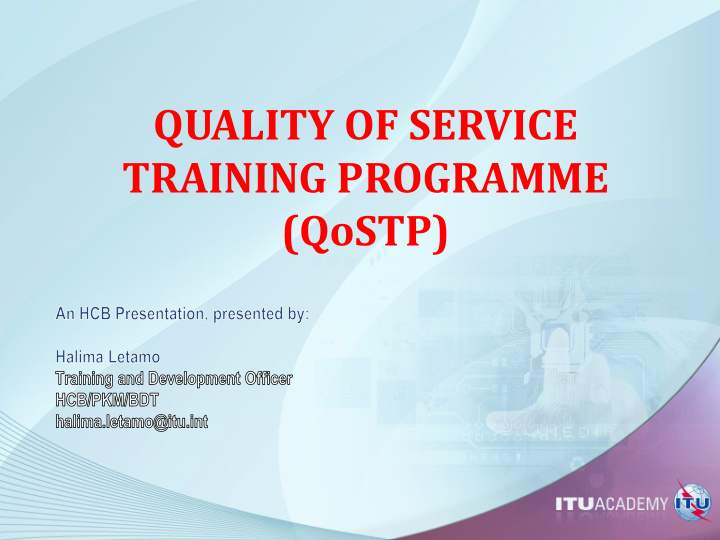



QUALITY OF SERVICE TRAINING PROGRAMME (QoSTP)
QUALITY OF SERVICE TRAINING PROGRAMME (QoSTP) Presentation Outline • Problem Statement, Solution and Implementation Process • QoSTP Structure, Composition and Certification Routes • Delivery Options • Next Steps
PROBLEM STATEMENT Availability of service is no longer a primary issue, whereas the quality of the service • provided is growing in importance; Quality - “the characteristics of a service/product that reflects its ability to satisfy stated or implied needs of users” ISO 9000 • It is closely linked to the issue of consumer rights and consumer protection; QoS in telecommunications is increasingly becoming an important Regulatory issue; • There is a need to disseminate firm and solid QoS understanding for all stakeholders, such • as operators, equipment manufacturers, administrations, regulatory bodies, end-users and their representatives; Today there are no formal complete QoS training programmes. •
SOLUTION: QoSTP • ITU developed a standardized training progamme in Quality of Service (QoSTP) • The QoSTP is the second in a series of high-level training programmes developed under the auspices of the ITU Academy
SOLUTION: QoSTP Objective To develop a full set of high-level training materials prepared by high caliber subject- matter experts, designed for anyone either a beginner or a specialist, which will: • Provide ITU membership with capacity building solutions in all areas of QoS; Offer access to QoS training and forward-looking professional vision; • Provide possibility for different certification options; • • Provide international recognition, with possible options of university credits/diploma
SOLUTION: QoSTP Benefits to ITU Preserving and spreading the wealth of QoS knowledge accumulated in • the ITU (TSB/BDT and ITU-T/D SG: staff’s know -how and Reports/Recs) Additional facet to the ITU’s global leadership role as enabler and • facilitator of ICT development Service to Member States and Sector Members • Course completion certificate as quality reference for candidates • assessment in ITU and administrations’ hiring processes
IMPLEMENTATION PROCESS Collaboration of efforts between ITU-T and ITU-D (task force to • coordinate development process) Conceptualization and development of the programme scope • Engage an external coordinator • • Identification of subject-matter experts within the global QoS community Preparation of high-level training materials by experts • Quality Assurance Process (peer-review) • Editorial Process • Establishment of partnership with universities and other partner • institutions in order to deliver the QoSTP and provide accreditation/certification
IMPLEMENTATION PROCESS Quality Assurance Course Coordinator Consistency across modules • Module linkages • Elimination of overlaps • Guidelines and Frameworks to standardize material • Peer review • Several review rounds through the course development process • Conducted by minimum 2 top experts in the field per module • Ensures that materials are technically up to date and of the highest standard Editorial Review Ensures that language and terminology used in the training • materials conforms to the rules, policies, procedures and instruments of the ITU. Once the product is out, it is of the highest quality •
QoSTP: STRUCTURE 6 Obligatory Modules OM0: Overview Module • OM1: Introduction - Quality of Service and Quality of Experience • OM2: Subjective assessment of voice quality • OM3: Objective assessment of voice quality • OM4: QoS and QoE for Multimedia and assessment methods • OM5: Regulatory Aspects of QoS •
QoSTP: STRUCTURE 4 Elective Modules EM1: • – Elective Module 1.1: Telephonometry – Elective Module 1.2: Network performance measurement – Elective Module 1.3: OAM for performance measurement EM2: • – Elective Module 2.1: Hands-free communication and user interfaces in vehicles – Elective Module 2.2: Traffic management • EM3: – Elective Module 3.1: QoS for mobile services – Elective Module 3.2: Bitrate measurement of Internet connections EM4: • ― Elective Module 4.1: Deployed QoS management technologies
QoSTP: COMPOSITION Each Module Consists of: An averag rage e of Task sks s for Exam m Syllabus labus card rd 400 400 Ppt slides des pract ctical ical questions stions and and an to cover ver 4-5 5 exercise rcises s answe wers rs for abstract tract weeks eks of (where ere testing sting (50- lecture ture appl plicab icable) le) 100 questions) stions)
QoSTP: CERTIFICATION ROUTES Basic Medium Advanced
QoSTP: CERTIFICATION ROUTES BASIC OM0: Obligatory Module 0- QoS/QoE Overview • Designed to cater for individuals at senior level positions who require only a broad overview of the topic OM1: Introduction- Quality of Service and Quality of • Experience
QoSTP : CERTIFICATION ROUTES MEDIUM QoS/QoE Specialist: • OM0-OM1-OM2-OM3-OM4-OM5; • End-user Equipment QoS Specialist: OM0-OM1-OM2-OM3-OM4-OM5-EM1.1-EM2.1-EM3.1-EM4.1 Fixed Network QoS Specialist: • OM0-OM1-OM2-OM3-OM4-OM5-EM1.2-EM1.3-EM2.2-EM3.2-EM4.1 Mobile Network QoS Specialist: • OM0-OM1-OM2-OM3-OM4-OM5-EM1.2-EM1.3-EM2.2-EM3.1-EM4.1
QoSTP: CERTIFICATION ROUTES ADVANCED Advanced End-user Equipment QoS Specialist: • OM0-OM1-OM2-OM3-OM4-OM5-EM1.1-EM2.1-EM4.1-final project/thesis Advanced Fixed Network QoS Specialist: • OM0-OM1-OM2-OM3-OM4-OM5-EM1.2-EM1.3-EM2.2-EM3.2-EM4.1- final project/thesis Advanced Mobile Network QoS Specialist: • OM0-OM1-OM2-OM3-OM4-OM5-EM1.2-EM1.3-EM2.2-EM3.1-EM4.1- project/thesis
QoSTP ORGANIZATION: LEVELS OM0 Introduction OM1 QoS and QoE Basic Exit Level OM2 Subjective ... OM3 Objective... OM4 Multimedia QOS OM5 Regulatory Aspects EM1-1 Telephonometry EM1-2 Network Performance EM1-3 OAM for Performance EM2-1 Hands-free&cars EM2-2 Traffic Management EM3-1 Mobile QoS EM3-2 Internet Bitrate EM4-1 Deployed QoS Management Techniologies Medium Exit Level Final Project/Thesis Advanced Exit Level
Next Steps • Editorial work • Conduct pilot training • Engage training providers for partnerships in the delivery of the training • Convert material to multimedia
QUESTIONS? For more information please contact hcbmail@itu.int or visit http://academy.itu.int
Recommend
More recommend